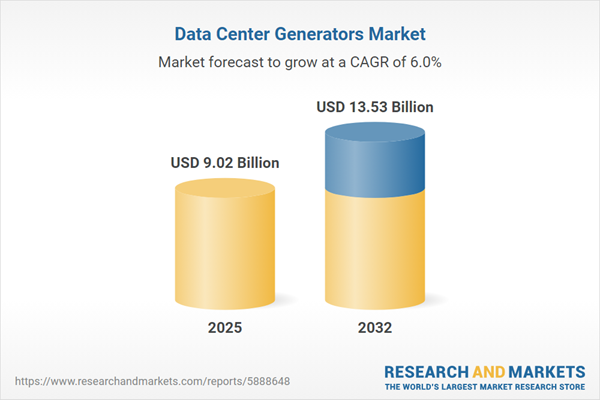Speak directly to the analyst to clarify any post sales queries you may have.
The data center generators market is a critical enabler of digital infrastructure resilience, offering dependable power continuity as organizations adapt to increased IT demands and evolving regulatory landscapes. Senior leaders face multifaceted challenges in sustaining uptime and supporting dynamic technology environments.
Market Snapshot: Data Center Generators Market Growth and Opportunity
The global data center generators market is projected to increase from USD 8.50 billion in 2024 to USD 13.53 billion by 2032, reflecting a steady compound annual growth rate (CAGR) of 5.98%. This expansion is driven by significant investments in cloud infrastructure, rapid edge computing adoption, and the widespread emergence of hyperscale data centers. As businesses prioritize consistent system availability, robust power generation solutions become essential for maintaining digital operations. Across different regions, evolving compliance obligations and local regulatory frameworks are intensifying demand for modular and scalable generator technologies, ensuring that infrastructure can align with both strategic agility and regulatory adherence.
Scope & Segmentation: Data Center Generators Market Segments
- Fuel Types: The market encompasses bi-fuel engines, advanced diesel options, natural gas-powered systems, and emerging hydrogen solutions, supporting varied sustainability goals, regulatory demands, and decarbonization plans.
- Power Ratings: Generators span from sub-500 kVA units tailored to edge facilities to large-scale systems above 2000 kVA, allowing adaptability for both small deployments and extensive enterprise or hyperscale locations.
- End Users: Colocation providers, enterprise IT teams, edge service stakeholders, and hyperscale operators each require tailored risk management approaches and infrastructure capabilities within diverse data center environments.
- Generator Types: Continuous, prime, and standby generators are available to support normal operations, address peak energy scenarios, and deliver emergency backup to protect uptime-sensitive facilities.
- Configurations: Products include mobile skid-mounted, trailer-based, and stationary installations, catering to disaster recovery, site expansion, and rapid deployment needs.
- Installation Methods: Modular indoor assemblies, prefabricated outdoor systems, containerized setups, and skid-based solutions maximize adaptability to various maintenance requirements and external conditions.
- Usage: Generator sets provide vital backup during grid interruptions, assist in peak load management, and maintain continuous ICT uptime across organizational operations.
- Cooling Technologies: Direct and indirect air systems, oil-immersed solutions, and direct liquid cooling optimize thermal management, particularly important for high-density installations.
- Regional Coverage: The Americas, EMEA, and Asia-Pacific drive unique procurement practices, regulatory perspectives, and technology adoption patterns shaping market strategies.
- Companies Assessed: The study evaluates Caterpillar Inc., Cummins Inc., Generac Power Systems, Kohler Co., Rolls-Royce Power Systems AG, MTU Onsite Energy GmbH, Wärtsilä Oyj Abp, Atlas Copco AB, Doosan Corporation, and Yanmar Co., Ltd., focusing on innovation, supply resilience, and market breadth.
Key Takeaways for Senior Decision-Makers
- Modular and digitally managed generators offer organizations the agility and operational risk control now required for both centralized and distributed data centers.
- The increased uptake of hydrogen and bi-fuel generators supports compliance with more stringent environmental regulations and long-term sustainability initiatives.
- Region-specific procurement and deployment strategies enhance efficiency, enabling streamlined compliance and optimized deployment timelines.
- Solutions integrating advanced diagnostics and real-time analytics facilitate predictive maintenance, improving availability and minimizing unplanned operational disruptions.
- Engaging a diverse supplier base mitigates risks linked to parts shortages and market price shifts, strengthening operational continuity.
- Flexible installation options, including mobile and containerized generators, enable responsive disaster recovery and expansion tailored to dynamic business requirements.
Tariff Impact: Navigating Cost and Supply Chain Shifts
Recent US tariffs on generator components are leading generator manufacturers to re-examine sourcing strategies and production locations. A growing reliance on localized manufacturing and the renegotiation of supply contracts are emerging as solutions to buffer against potential supply interruptions and stabilize operational expenditures. These adjustments require proactive capital planning by procurement and financial leaders, while operational teams increasingly rely on analytics-driven maintenance to help sustain power reliability in a shifting market environment.
Methodology & Data Sources
This research leverages a combination of sector analyses, in-depth expert interviews, and findings from independent review panels. Each data point has undergone a multi-stage validation process to ensure reliability and actionable accuracy for executive and board-level stakeholders.
Why This Report Matters
- Provides segmented analysis and actionable recommendations for future-proof generator deployment and procurement strategies within enterprise data centers.
- Equips leaders with timely updates on technology evolution, compliance trends, and sustainability factors essential for business continuity.
- Enables proactive management of regulatory and sourcing risk, ensuring ongoing infrastructure performance and resilience.
Conclusion
This comprehensive evaluation equips senior executives with the insight to strategically align data center generator investments with sustainability, compliance, and resilience objectives, enabling organizations to strengthen digital infrastructure as market and regulatory pressures evolve.
Additional Product Information:
- Purchase of this report includes 1 year online access with quarterly updates.
- This report can be updated on request. Please contact our Customer Experience team using the Ask a Question widget on our website.
Table of Contents
3. Executive Summary
4. Market Overview
7. Cumulative Impact of Artificial Intelligence 2025
Companies Mentioned
The companies profiled in this Data Center Generators market report include:- Caterpillar Inc.
- Cummins Inc.
- Generac Power Systems, Inc.
- Kohler Co.
- Rolls-Royce Power Systems AG
- MTU Onsite Energy GmbH
- Wärtsilä Oyj Abp
- Atlas Copco AB
- Doosan Corporation
- Yanmar Co., Ltd.
Table Information
| Report Attribute | Details |
|---|---|
| No. of Pages | 185 |
| Published | November 2025 |
| Forecast Period | 2025 - 2032 |
| Estimated Market Value ( USD | $ 9.02 Billion |
| Forecasted Market Value ( USD | $ 13.53 Billion |
| Compound Annual Growth Rate | 5.9% |
| Regions Covered | Global |
| No. of Companies Mentioned | 11 |









